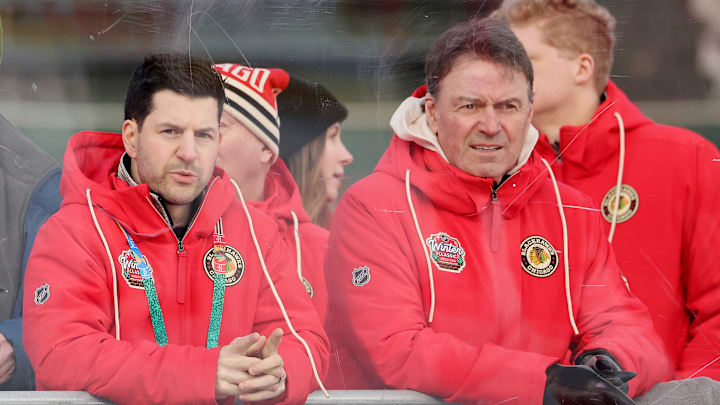Some readers may scoff at the suggestion that this young Blackhawks team should consider selling off future assets, such as first-round picks. However, when you begin to examine the Chicago Blackhawks' organizational depth, it becomes obvious that buying is not only a good idea, but it is completely essential.
Too much of something good can be a problem
Look, I have been, and remain, a huge advocate of Kyle Davidson's approach to this rebuild. He meticulously disassembled the aging and underperforming Blackhawks roster and acquired a mountain of draft picks, which he has used to mold the new generation of stars in Chicago. It is sound logic, and the theory that more "darts at the board" will inevitably lead to finding key contributors is clearly logical. However, at some point, it becomes a major problem to have too many first-round draft selections. Here's why.
It is crucial to remember that first-round picks are projected to be contributing NHL-caliber players. If they don't become that, it is a failure. The Blackhawks have drafted 11 times in the first round of the NHL draft under Kyle Davidson in just four years. That's great, but the problem becomes that you have to find a spot for all of those guys when they are ready to jump to the NHL in a year or two or three. The Blackhawks already have Connor Bedard, Frank Nazar, Oliver Moore, Sam Rinzel, and Artyom Levshunov of those first-round picks in the NHL, and soon, others will join them.
When you project out who is expected to be here when the Blackhawks are really good, let's say, in three years, it becomes clear that most Hawks fans don't realize just how serious a roster problem the Blackhawks have. At forward, the Blackhawks will have to fit in the following players: Bedard, Nazar, Moore, Nick Lardis, Anton Frondell, Roman Kantserov, Marek Vanacker, Sacha Boisvert, Mason West, Ryan Greene, Vasclav Nestrasil, and whichever two first-rounders they pick in the upcoming draft. That alone is 13 forwards, and it isn't counting guys like Ryan Donato, Tyler Bertuzzi, Ilya Mikheyev, Teuvo Teravainen, or any other veteran you want to bring in.
The fact is that, unfortunately, the Blackhawks do not have enough room for all these guys. They would have to lose four to five of the above players to have a proper forward group. And that is assuming you play players like Vanacker, Lardis, West, or any of the others in the bottom six, which could easily hinder their development. The Hawks are rapidly running out of room to add new young players to this group. The solution, therefore, is clear. Sell several good young prospects for one great top-line forward.
Trade Deadline Vision:
In my opinion, the Blackhawks would be wise to pay close attention to which teams are underperforming badly this season, to identify where they can strike to land a star player via trade. Some teams that are off to rough starts so far are, for example, the St. Louis Blues, the New York Rangers, the Buffalo Sabres, the Calgary Flames, and the Nashville Predators. There are lots of top-line players on those teams, and I would imagine that they would be willing to package one of them in a trade if their season falls apart. Remember that teams with little to no prospect depth are salivating at the chance to land Gavin McKenna this summer.
So hypothetically, would you be interested in a trade like this: Vanacker, the Panthers' first-round pick in 2026, the Blackhawks' second-round pick in 2026, and Mikheyev for a player like Artemi Panarin, who may not resign in New York if they fail to remain competitive? Or how about Jordan Kyrou? Or Alex Tuch? The time is now to be aggressive and use some of the mountain of young assets that the Blackhawks have to go out and get a clear-cut, no doubt, top-line winger to play with Bedard.
Ultimately, I don't know what Davidson will do. However, I think it would be wise for him to look at what his team might look like several years from now and how he will pay and fit all these young top-six caliber players on the Blackhawks. It would be a better use of the Blackhawks' assets to combine several B-tier assets for one clear A-tier asset, like Panarin. Here's hoping the Blackhawks act aggressively and get it done.
